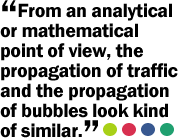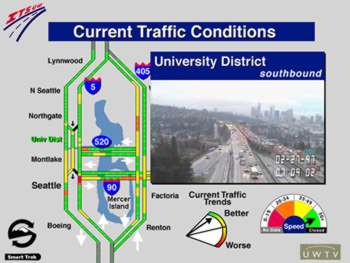
UW-Caused Congestion Actually Decreases
Hallenbeck's latest project takes traffic data and converts it into images and numbers that describe the various dimensions of congestion: time (how long are you stuck?), severity (how badly are you stuck?), geography (how far are you stuck?) and temporal (how long does the problem last?).

The graphics provide a way to gauge whether transportation strategies are doing what they were intended to do.
For example, the numbers show that, believe it or not, in some areas congestion around the University District has shown slight improvements, Hallenbeck says.
A comparison of data from 1995 to data taken in 1997 shows a distinct drop in how often State Route 520 becomes congested during the morning commute to the University District—a commute heavily influenced by UW employees. Significant congestion occurs one or two days a month less often in 1997 than it did in 1995. Crowded conditions still routinely occur from about 6:30 a.m. to 9:30 a.m., but this time frame has not expanded since 1995.
In sharp contrast, the afternoon commute in the same direction (coming into Seattle), a flow heavily influenced by people who work on the Eastside and live in Seattle, shows marked increases in both how often significant congestion occurs and what times during the day that congestion occurs. Heavy afternoon congestion now routinely occurs as early as 2 p.m. and can last until nearly 8 p.m. There is a 20 percent greater chance of finding heavy congestion at 3:30 p.m. in 1997 than there was in 1995.
Programs such as U-Pass, which provides UW employees with a heavily subsidized bus pass, are a major reason why the morning commute into Seattle on 520 is bucking the otherwise growing trend of congestion in the region, Hallenbeck says.
The analyses also bring insight into current hotly contested transportation issues, such as High Occupancy Vehicle (HOV) lanes. Critics of the lanes, which are supposed to be used only by vehicles with two or more persons, say the lanes should be opened to all to make maximum use of highway space. Supporters say the lanes encourage carpooling and mass transit and are a necessary part of the area's overall transportation strategy.
"We can show that the HOV lanes in this area have been a huge success during peak hours," Hallenbeck says. "We can also show that if you take those people in HOV lanes out of the buses and put them in cars, it will be an utter disaster."
According to Hallenbeck's figures, during peak commute hours freeway HOV lanes move more people in fewer vehicles than the general-purpose lanes next to them.

A demonstration of a prototype viewing format for Traffic TV, a "Weather Channel" for traffic broadcast on UW's experimental cable channel.
During the afternoon commute north on I-5, for example, the HOV lane carries just under 16,000 people, while the general-purpose lane next to it carries about 8,000. If the HOV lanes were opened, many people would likely opt to drive their own vehicles. The data on I-5 indicate that if just 7 percent of the people now carpooling or riding the bus decide to drive their own cars, congestion would increase, even though all vehicles could use the extra capacity available in the HOV lane.
Hallenbeck's next report is due out in a couple months.
Congestion solutions don't come easy for a freeway system as large and variable as Seattle's. Projections call for a continued flow of people into the Pacific Northwest, with the Puget Sound population increasing as much as 50 percent by 2020. More people will mean more cars and potentially more gridlock. Can technology rescue us from highway hell? That depends, researchers say. The real question is whether commuters and residents will opt to participate.
The bottom line, according to Dailey, is to get information out so people can make informed choices.
"We all live in traffic," he says. "The better we understand it, the better we can make good decisions to cope with it."
- Return to June 2000 Table of Contents